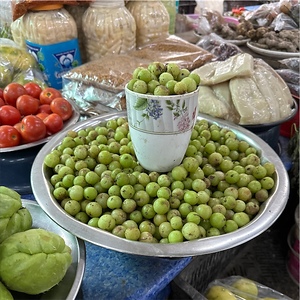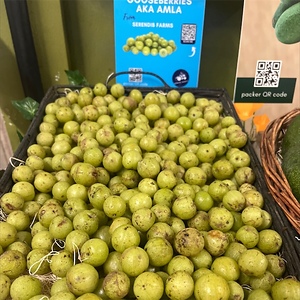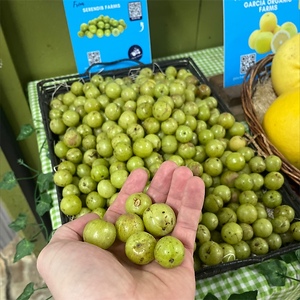


Foraged Naga Gooseberries
Estimated Inventory, lb : 0
Description/Taste
Naga gooseberries are small in size, averaging 1 to 3 centimeters in diameter, and have a round to oval shape with blunt, curved ends. The fruit’s skin is thin but tough, taut, semi-smooth, and firm, showcasing yellow-green hues. The surface also features faint pale green to yellow striations and is sometimes covered in brown markings and patches caused by damage during growth. Underneath the surface, the pale green flesh is hard, dense, lightly aqueous, and fibrous with a chewy, occasionally chalky to crisp consistency, depending on the degree of ripeness. The flesh encases a green to brown stone that houses 1 to 6 tiny seeds. Naga gooseberries are edible raw or cooked and have a sour, bitter, and astringent flavor. The fruits are typically eaten with salt and chile peppers for enhanced flavoring or cooked with sugar to create a sweeter taste.
Seasons/Availability
Naga gooseberries ripen in the fall and are typically harvested from October through February.
Current Facts
Naga gooseberries, botanically classified as Phyllanthus emblica, are a wild species belonging to the Phyllanthaceae family. The small, sour fruits are a type of wild Indian gooseberry and are seasonally foraged as a medicinal and culinary ingredient in Nagaland, a state in Northeastern India. It is important to note that there are many different varieties of Indian gooseberries grown throughout Southern Asia, especially in India, and each region will have fruits that display different characteristics. Naga gooseberries grow on deciduous trees reaching 1 to 8 meters in height and are distinct from cultivated Indian gooseberries in size, shape, and texture. Wild Indian gooseberries, such as Naga, are typically smaller, have a hard, fibrous texture, and weigh around 5.5 grams. Cultivated Indian gooseberries are larger, fleshier, and juicier, weighing around 28 to 56 grams. In Nagaland, wild gooseberries are harvested by hand. The fruits are foraged from trees on the edges of villages and in wooded areas, and the fruits are collected using ladders, sticks to shake the trees, or climbers to scale the trunk and pick the fruits. Wild gooseberries are gathered in cane baskets or fine mesh nets and are carried into towns where the fruits are eaten fresh, cooked, pressed into beverages, dried, or used for medicinal practices. Naga gooseberries are prevalent throughout Nagaland and are known simply as Gooseberries, Choroshi or Chiiroshi among the Mao tribe, and Kholethi in the Sumi tribe. Outside of Nagaland, Indian gooseberries are called Amla in Hindi, meaning “sour,” Amlokhi, Amlaki, and Poramlokhi in Assam, and Amalaki in Sanskrit. All varieties of Indian gooseberries are favored throughout India as a healing ingredient, and the fruits have been incorporated into Ayurvedic practices since ancient times.
Nutritional Value
Naga gooseberries, like other types of Indian gooseberries, are a source of vitamin C to boost the immune system, vitamin E to reduce inflammation, fiber to regulate the digestive tract, and calcium to build strong bones and teeth. Gooseberries also provide iron to develop the protein hemoglobin for oxygen transport through the bloodstream, vitamin A to maintain healthy organ functioning, antioxidants to protect the cells against the damage caused by free radicals, and other nutrients, including B vitamins and phosphorus. In Northeastern India, varieties of Indian gooseberries are pressed, boiled, and mixed with water as an eye drop solution. The juice from the fruit is also said to reduce swelling when applied topically around the eye. Naga gooseberries are used to maintain healthy digestion, soothe inflammation in the throat, and improve heart health. The fruits are made into pastes, dried and ground into powder, or made into tea for various medicinal practices. In Ayurveda, Indian gooseberries are said to pacify the three doshas and have five of the six tastes, helping to improve appetite and digestion. Indian gooseberries are also believed to enhance hair thickness and skin texture in India.
Applications
Naga gooseberries have a sour, bitter, and astringent taste suited for fresh and cooked preparations. The wild fruits are typically washed, coated in salt and chile powder, and eaten as a zingy snack. Salted gooseberries are a customary dish served at the end of meals to aid digestion. Naga gooseberries are also soaked in salt water to reduce their bitter nature. Once prepped, the raw fruits can be made into pickles, added to various chutneys, or used as flavoring for vinegar and marinades. In Nagaland, a popular preparation is boiling the fruits in sugar, drying them, and selling them as tangy-sweet candies. The fruits are also sundried and pounded into pieces with salt, dried ginger, and green chiles. Candied gooseberries are widely sold as a treat in Naga markets, festivals, and during special events. Naga gooseberries are also added to curries and soups. Beyond culinary dishes, Naga gooseberries are utilized in various beverages and syrups. The Ao tribe combines gooseberries with white tea leaves into a hot drink, and the fruits are washed, boiled, and left to ferment to make a gooseberry wine, also known as gooseberry beer. Naga gooseberries pair well with citrus juice, salt, sugar, cabbage, other leafy greens, meats such as pork, fish, and poultry, and aromatics including ginger, garlic, and onions. Freshly harvested Naga gooseberries should be immediately consumed for the best quality and flavor. The fruits can also be dried and stored in an airtight container in the refrigerator or in a cool, dry, and dark place for a few days. Dried Naga gooseberries can keep up to one year.
Ethnic/Cultural Info
Naga Wild gooseberries are part of a well-known folk tale shared among the Sumi tribe of Nagaland. The story is about a group of villagers traveling down the mountains to the plains to barter for goods. This group had a reputation for making poor decisions, and after the villagers had finished bartering for items such as salt, they began the walk home. The group stopped by a stream to eat some wild gooseberries and drink water. The sour fruits overwhelmed their tastebuds with bitter, tangy notes, so when they drank the fresh water, the liquid tasted sweet. The group was astounded that the water could taste so sweet and believed it must be a special type of water, so they left behind many of the items they bartered for to carry the sweet water back to the village. When they arrived at the village, they presented the water, but the other villagers said the water tasted normal and were upset the group had left behind the bartered items. Despite this story being mostly a whimsical folk tale to convey a moral message, there is some truth to gooseberries' altering tastebuds. It is said the fruit’s vitamin C content may have something to do with making water taste sweet. It is also thought that the extreme sourness of the fruits makes even mild-flavored items, such as water, taste sweet. This phenomenon is still experienced in the modern day and is being explored by researchers.
Geography/History
Naga gooseberries are native to Southern Asia and have been growing wild since ancient times. The wild fruits are a type of Indian gooseberry and are primarily localized to Northeastern India. Indian gooseberries, in general, are thought to be one of the first fruit trees created in India, according to Indian mythology. One creation myth involves Vishnu. Legend has it that when Brahma was involved in Vishnu’s meditation, tears began to fall from Visnhu’s eyes. The tears dropped to the earth and sprouted gooseberry trees. The second myth ties gooseberries to drops of a sacred syrup known as Amrit. The immortal liquid was spilled during a fight between gods and demons after the Sagara Manthan, a mythological event known as the churning of the ocean, and gooseberry trees formed from the drops. Indian gooseberries, including Naga gooseberries, thrive in semi-arid, dry, and subtropical climates and have resistance to cold temperatures. The fruits grow on small trees typically found on the outskirts of villages and are naturally scattered through deciduous forests. In Nagaland, Naga gooseberries are prevalent in the wild and are present throughout the state. In Kohima, the capital city, Naga gooseberry trees are easily found in nearby villages and are foraged in the fall and winter. The fruits are sold fresh in local markets or processed into candies, beverages, and dried goods for purchase at carnivals, night markets, and village shops. It is common to see Naga gooseberries drying on large, hand-woven flat baskets in the villages, and the fruits are placed in the sun in village squares, windows, along stone walls, and beside doorways. Outside of Nagaland, Indian gooseberries are primarily foraged and cultivated in Uttar Pradesh, Madhya Pradesh, and Tamil Nadu. The species is also found wild throughout the states in Northeastern India. Indian gooseberry products, mainly capsules and powders, are sold domestically and exported to Europe, Southeast Asia, Japan, and the United States. The Naga Wild gooseberries featured in the photograph above were sourced through the Mao Market in Kohima, Nagaland.
Recipe Ideas
Recipes that include Foraged Naga Gooseberries. One
| Rumicooks |
|
Indian Gooseberry Chutney |
| Elephants and the Coconut Trees |
|
Pickled Indian Gooseberries |
| Swapna's Cuisine |
|
Indian Gooseberry Wine |
| Curry & Vanilla |
|
Indian Gooseberries in Yogurt Sauce |










